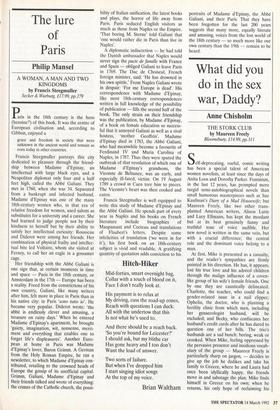The lure of Paris
Philip Mansel
A WOMAN, A MAN AND TWO KINGDOMS by Francis Steegmuller Secker & Warburg, £17.99, pp.279 Paris in the 18th century is the hero (heroine?) of this book. It was the centre of European civilisation and, according to Gibbon, enjoyed a
grace and freedom in society that were unknown in the ancient world and remain so even today in other countries.
Francis Steegmuller portrays this city dedicated to pleasure through the friend- ship between Madame d'Epinay, an intellectual with large black eyes, and a Neapolitan diplomat only four and a half feet high, called the Abbe Galiani. They met in 1760, when she was 34. Separated from a bankrupt and infected husband, Madame d'Epinay was one of the many 18th-century women who, in that era of relative freedom for women, used salons as substitutes for a university and a career. She had learned to judge people not by their kindness to herself but by their ability to satisfy her intellectual curiosity: Rousseau and Diderot were among her friends. Her combination of physical frailty and intellec- tual bite led Voltaire, whom she visited at Ferney, to call her an eagle in a gossamer cage.
Her friendship with the Abbe Galiani is one sign that, at certain moments in time and space — Paris in the 18th century, or Amsterdam in the 17th — Europe has been a reality. Freed from the constrictions of his own country, Galiani, like many writers after him, felt more in place in Paris than in his native city: in Paris 'sow tutto io'. He became very popular. Diderot wrote: 'the abbe is endlessly clever and amusing, a treasure on rainy days.' When he entered Madame d'Epinay's apartment, he brought 'gaiety, imagination, wit, nonsense, merri- ment and everything that enables one to forget life's displeasures'. Another Euro- pean at home in Paris was Madame d'Epinay's lover, Baron Grimm. A German from the Holy Roman Empire, he ran a newsletter, to which Madame d'Epinay con- tributed, retailing to the crowned heads of Europe the gossip of its unofficial capital. Grimm, Galiani, Madame d'Epinay and their friends talked and wrote of everything: the crimes of the Catholic church, the possi-
bility of Italian unification, the latest books and plays, the horror of life away from Paris. Paris seduced English visitors as much as those from Naples or the Empire. 'That boring M. Sterne' told Galiani that 'one would rather die in Paris than live in Naples'.
A diplomatic indiscretion — he had told the Danish ambassador that Naples would never sign the pacte de famille with France and Spain — obliged Galiani to leave Paris in 1769. The Duc de Choiseul, French foreign minister, said: 'He has drowned in his own spittle.' From Naples Galiani wrote in despair: 'For me Europe is dead'. His correspondence with Madame d'Epinay, like most 18th-century correspondences written in full knowledge of the possibility of publication — fills the second half of the book. The only strain on their friendship was the publication, by Madame d'Epinay, of a book on female education so success- ful that it annoyed Galiani as well as a rival hostess, 'mother Geoffrin'. Madame d'Epinay died in 1783, the Abbe Galiani, who had meanwhile become a favourite of Ferdinand IV and Maria Carolina of Naples, in 1787. Thus they were spared the outbreak of that revolution of which one of Madame d'Epinay's grandsons, the Vicomte de Belsunce, was an early, and especially ill-fated, victim. On 19 August 1789 a crowd in Caen tore him to pieces. The Vicomte's heart was then cooked and eaten.
Francis Steegmuller is well equipped to write this study of Madame d'Epinay and the Abbe Galiani. He spends part of every year in Naples and his books on French literature include biographies of Maupassant and Cocteau and translations of Flaubert's letters. Despite some infelicities of translation ('we were in for it'), his first book on an 18th-century subject is vivid and readable. A gratifying quantity of quotation adds conviction to his portraits of Madame d'Epinay, the Abbe Galiani, and their Paris. That they have been forgotten for the last 200 years suggests that many more, equally literate and amusing, voices from the lost world of the 18th century — so much more like our own century than the 19th — remain to be heard.


























































 Previous page
Previous page